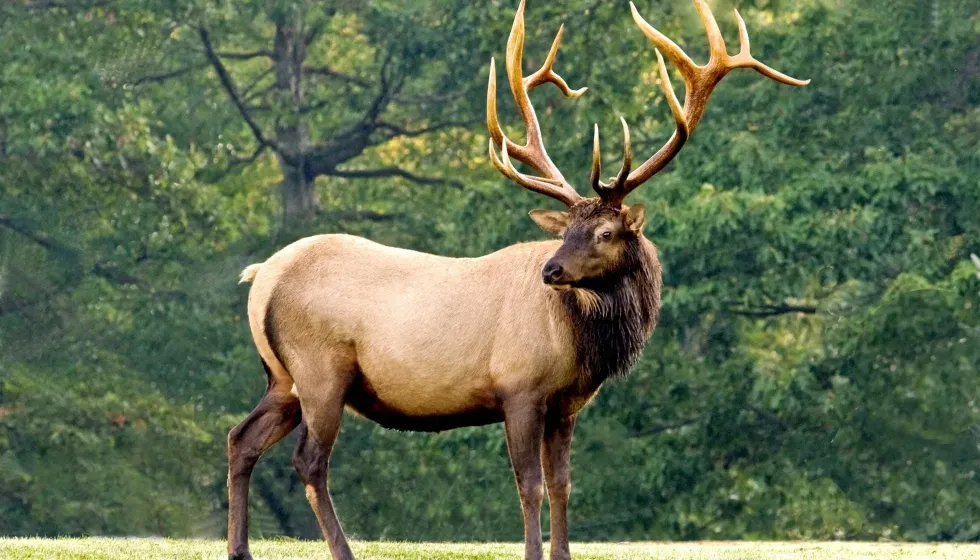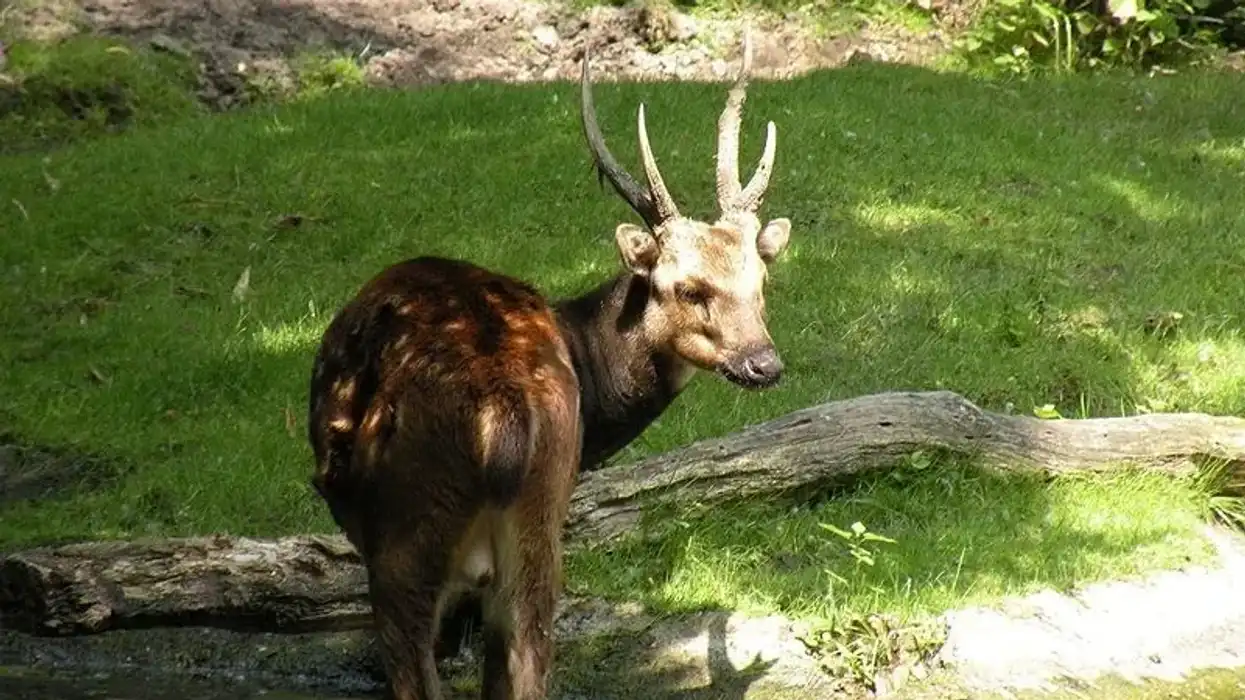The giant ice age Irish elk is neither exclusively from Ireland nor actually an elk. But it is called the giant deer or Irish giant deer, which went extinct.
It was found in Eurasia during the Pleistocene Epoch or the glacial period of the last million years, from Ireland to Lake Baikal, in present-day Russia. The Irish elk skeleton was found in the bogs in Ireland and along with the first fossils.
The species is closely related to red deer or the fallow deer. It is actually a deer and not an elk.
It was found in Northern Asia, Europe, and Northern Africa. It is said that these animals with massive antlers were not able to adapt to the subarctic conditions from the last glaciation or the last transition, which marked the final retreat of the ice sheet.
The last one probably died 7,700 years ago in Ireland.
The Irish elk had antlers that were around 12 ft (365.76 cm) in length and weighed 88 lb (39.9 kg). The Irish elk was known as the heaviest cervine or deer.
The giant deer had a strong Irish elk skeleton that supported its massive size pretty well.
According to some Palaeolithic cave paintings, the giant deer had a light colored body with a dark stripe on the back, another one from shoulders to haunch, a dark-colored collar on the throat, and a chinstrap with a dark hump between their shoulders.
Thousands of years ago, Irish elk used to roam around and now only Irish elk skeleton can be studied, this is the lethal power of evolution that ensures the survival of the fittest.
Here are some fascinating facts about the Irish elk skeleton and other aspects of this species that went extinct.
After reading about the extinction of the Irish elk species, do check our other articles on percheron facts and axis deer facts.
Irish Elk Interesting Facts
What type of animal is an Irish elk?
The ice age elk or Irish elk is a type of giant deer species which went extinct. It was the largest deer and the biggest deer species to ever walk the earth on the North American side. It was found in the Eurasia region along with North Africa. It was found during the Pleistocene Epoch times.
What class of animal does an Irish elk belong to?
The giant Irish elk size is the largest deer and giant deer of antler size and is believed to be a mammal as it gives birth to one offspring like many mammals.
How many Irish elk are there in the world?
There are no Irish elks left in the world now. Scientists have discovered many fossils, skeletal remains, and cave paintings of these fascinating animals prepared by ancient humans.
As per carbon dating of the latest Irish elk skeleton, the last member of this species died around 7,700 years ago, leading to the extinction of this animal from Ireland (the Irish elk extinction).
Where does an Irish elk live?
As per the Academy of Natural Sciences of Drexel University, the Irish elk lived mostly in their habitats across grasslands, boreal steppe-woodland regions of Ireland along with ancient humans. These regions mostly had pine and spruce scattered across along with low-lying herbs and shrubs, live sedges, grasses, ephedra, Chenopodiaceae, and artemisia.
What is an Irish elk's habitat?
The massive and enormous Irish elk was found in the Eurasian region from the Atlantic Ocean in the west to Lake Baikal in the east. These animals with large antlers were found in the grasslands south of the open mammoth steppe.
They covered the chronostratigraphic distribution in the middle Pleistocene or upper biharian to late pleistocene or epigravettian. At present, their skeletal remains, including the massive skull, can be found at the Natural History Museum, Dublin, or the Academy of Natural Sciences of Drexel University.
Who do Irish elk live with?
Not much is known about the massive and enormous elks’ behavior, as we haven’t witnessed this animal. Judging by the deer's behavior pattern, we may conclude that Irish elk may live in groups. It underwent extinction a long time ago.
How long does an Irish elk live?
As per the lifespan of the massive red deer, which is considered to be closely related to the now-extinct Irish elk, we may conclude its lifespan was around 10-13 years.
How do they reproduce?
Not much is known about the massive elks’ mating rituals. Judging from the breeding behavior of other elks or deers, we may conclude that it may be similar to theirs.
The male elk will compete with other males to get included in the female herds. Males will try to intimidate rivals by vocalizing and displaying their antlers.
If males do not back down, they may engage in antler wrestling which may also cause serious injuries. A male elk will defend his harem of 20 cows or more from competing males and predators.
The male elk will try to check if the female elk is ready or not by flicking his tongue. If a female elk is not ready, the uninterested female elk will move aside by lowering her head and weave while opening and closing her mouth.
This will make the make male stop. Once the female elk is ready, the male will lick her and then mount her.
The female gives birth to one or, on very rare occasions, two offspring after a gestation period of 240-262 days. When the female elk is about to give birth, she will separate herself from the group and remain alone with her baby till it is large enough to escape predators.
What is their conservation status?
The Irish elks are now extinct animals, who lived on the planet some 7700 years ago. Their extinction was due to the shrinking ice sheet on the planet. Their skeleton, including the massive skull, is available at the Museum of Natural History, Dublin.
Irish Elk Fun Facts
What do Irish elk look like?
The Irish elk was known for its body size as the heaviest cervine or deer. They had a stronger skeleton which was mature and older in body size.
According to some Palaeolithic cave paintings, they had a light-colored body size with a dark stripe on the back, another one from shoulders to haunch, a dark colored collar on the throat, and a chinstrap with a dark hump between their shoulders.

*Please note that this is an image of a bull elk, not an Irish elk specifically. If you have an image of an Irish elk, please let us know at hello@kidadl.com.
How cute are they?
They are majestic creatures with a height and weight that could tower over any human easily, especially their antlers which are still found in many Irish houses.
How do they communicate?
Not much is known about their communication pattern, vocal or non-vocal as they are an extinct species.
How big is an Irish elk?
The Irish elk was the largest and the heaviest deer to have walked the earth. Sadly, the species has been extinct for many centuries now. Its height has been estimated at 6.90 ft (210.3 cm) without antlers and around 11.98 ft (365.15 cm) with antlers. The body size was in the range of 5.2-8.8 ft (158.49-268.22 cm).
How fast can an Irish elk move?
We cannot judge the speed of the Irish elk as we have not seen them. It has been centuries since its extinction. But judging by deers, we may conclude that they loved to roam freely around their habitat. They may have been migratory creatures, too as some of the fossils have been found in Northern Africa as well.
How much does an Irish elk weigh?
The Irish elk may weigh 990-1,320 lb (449.05-598.74 kg), with almost 88 lb (39.9 kg) being the weight for the antlers only.
What are their male and female names of the species?
If we go by the male and female names for present-day North American elk, we can say that the male Irish elk would be called a buck, and the female would be called a doe.
What would you call a baby Irish elk?
Baby Irish elk would be called fawn.
What do they eat?
As per some studies about the life of the Irish elk, we may say that they were both a grazer and a browser. It may be feeding on plants like artemisia and Asteraceae, helianthemum, plantago salix, and plumbaginaceae.
They ate more of grass and grass-based diet along with some browsing. They followed a mixed eating pattern of grazing and feeding along with a whole lot of leaf browsing.
Are they dangerous?
They may not be harmful to humans, which can be concluded by the behavior of deers in the present time.
Would they make a good pet?
They are an extinct species of giant deers that have not walked this earth for more than 7700 years now.
Did you know...
Irish elks are known to be an important species in the evolution process and how climatic changes and human encroachment led to the extinction of many large species around the same time.
The decreasing size of the antlers of the Irish elk made us understand that it was an evolutionary process to ensure survival.
During its lifetime on this earth, the Irish elk rarely interacted with the humans; this can be concluded from the very few paintings found depicting them as compared to the abundant painting of the red deer or reindeer.
The preserved skeletal bones and heads with complete antlers fetch good prices in the markets and are therefore found in many rich houses of Eurasia.
The Irish stag may need to consume almost 90 lb (40.8 kg) of fresh forage daily along with protein to support their antler growth, which helps us conclude that they needed nutritionally dense forage with steady availability of minerals for their evolution.
Why did the Irish elk become extinct?
There is a study that says that the Irish elk was a rare species back then, too. It has been concluded that they couldn’t adapt to the large antlers on their heads as it made escaping their predators, especially the human hunters, difficult.
Also, they may have had difficulty finding nutritionally dense food when the climatic changes brought about the change in vegetation.
This could lead to less sexual activity and procreation. Eventually, the size of the body and the antlers due to the change in vegetation, which caused a lack of sufficiently high-quality feed, happened by the late Pleistocene and into the Holocene.
How does the Irish elk compare to other elks?
Irish elks are not elks but deer and are now extinct. They were the largest and heaviest deer species on the earth. They are closely related to the red deer and fallow deer. They may have antlers like the elk and other similarities too, but they are not elks.
Here at Kidadl, we have carefully created lots of interesting family-friendly animal facts for everyone to discover! For more relatable content, check out these reindeer facts and caribou facts.
You can even occupy yourself at home by drawing one on our Irish Elk coloring pages.
* Please note that this is an image of a bull elk, not an Irish elk. If you have an image of an Irish elk, please let us know at hello@kidadl.com.










